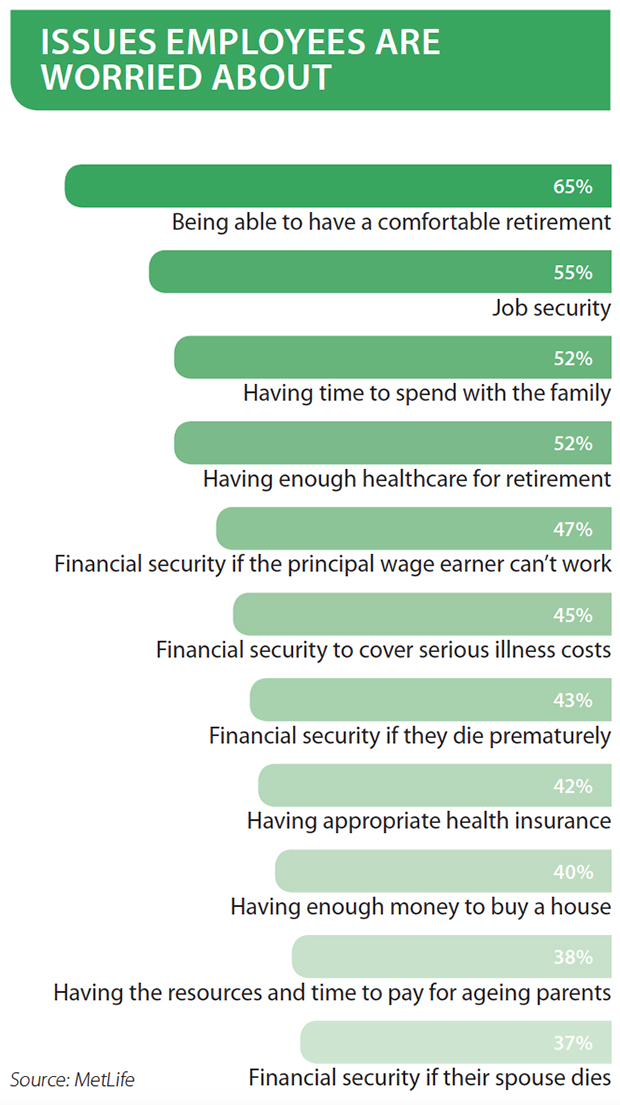Group risk benefits are often perceived as being better suited to certain age demographics, rather than an entire workforce. But the reality is, with state benefits being withdrawn and employees living and working longer, group risk benefits have never been more relevant to all staff. In particular, these issues make younger employees the most important age group to insure.

If you read nothing else read this…
- Benefits are more relevant to younger employees than they realise.
- Blanket group risk communications skew relevance.
- Younger employees getting a mortgage need insurances as a collateral for lenders to see.
- Technology can help improve employee perception of the relevance of group risk benefits.
A large proportion of this group will have no savings, and if something was to happen that would remove their income then their options would be limited. This can put pressure on employers to make benefits such as group income protection and critical illness insurance available.
John Ritchie, chief executive officer of Ellipse, says: “What makes risk benefits so relevant to this demographic is that younger generations will do slightly more riskier things in life, jumping off cliffs on holiday for example; driving fast is another. The biggest risks for this group are becoming disabled or having a critical illness. Risk is always there, which makes having a policy even more relevant if an employee is young.”
But relevance can be hindered by the uncertainty around which group risk benefits are leading to even more confusion. It becomes difficult for employees to see the relevance when organisations offer blanket communications, says Tom Gaynor, employee benefits director at MetLife UK.
“Group risk benefits are relevant to all age groups and maybe even more relevant to younger employees than they think or realise,” he says. “The need to have protection is important but it is an unknown area to this demographic. It becomes a problem when employers do blanket communications. People need to know where they can get these benefits from before they need them.”
Forward-thinking employers will communicate what they have and how this links to employees’ needs, with specific and segmented communication key for the younger generation.
During an organisation’s communication efforts, the use of the word ‘group risk’ should not be used in the language when talking to members. It is about death and health catastrophes, as well as hard-hitting messages to get the relevance across to engage younger employees.
Matthew Lawrence, head of broking at Aon Employee Benefits, says: “Communication needs to educate employees and raise awareness of what these benefits are and how they work in an event of something happening. It is really about showing to the workforce that, as an organisation, it cares about employees of all ages.
“In an ideal world, the employer should tailor the communications by segmenting the workforce because the younger generation Y are more online savvy. That way, the benefits of protection under a group risk policy may well influence the relevance and create engagement.”
According to the UK employee benefit trends study by MetLife, published in May 2015, take-up of group risk policies could potentially treble when offered via flexible benefits schemes if the benefit was partially funded by employers. The research estimated that take-up of life insurance, for example, could potentially rise from 23% to 59%.
Including such benefits within a flex scheme could also allow younger employees to be more active by flexing up and down their level of cover. Meanwhile, the use of technology, such as wearable technology, could also help raise awareness and relevance among the younger demographics.
The use of clear messages around the added-value benefits that come with group risk policies will also enhance potential take-up among staff.
Paul Avis, marketing director at Canada Life, says: “More often than not, the financial benefit does not have relevance to younger employees, but it is the additional value-added services, for example the ability [to use] an employee assistance programme to talk through debt, buying a home or consumer legal issues. These provide a service to be used on a daily basis without claim.”
There are signs of comfort for employers, with the number of employees in the UK covered by group risk insurance growing by 200,000 in 2014, according to the Swiss Re Group watch 2015 report. However, despite this statistic, organisations take a paternalistic approach when putting in group risk benefits for their employees.
Ron Wheatcroft, technical manager at Swiss Re, says: “An employer will only put a group risk policy in place if it sees the benefit to itself and it is very paternal. But there are positives. In our research, we have seen most figures go up. Yet employers face challenges to make group risk relevant to younger employees and there is a need to show it in benefits statements and flex arrangements. Technology will make it cheaper to deliver messages and opens it up to younger employees to engage and remind them what cover they have got.”
Case study: Arup employees engage with group risk benefits

Professional services firm Arup provides a minimum level of cover of group risk benefits for its younger employees to help protect dependants or family members if the worse should happen.
The organisation feels that providing protection for its employees is necessary to protect the business.
It offers four different types of group risk cover: life assurance at four-times salary, income protection, critical illness insurance and personal accident insurance.
Evan Davidge, head of reward at Arup, says: “We have a moral responsibility to provide minimum protection to employees and allow them the opportunity to have extra cover if they wish [through flex].
“The benefits are relevant because younger members of staff think they are indestructible.”
However, its strategy changed to put more of a focus on reducing the likelihood of employees needing to use such benefits and going off sick, launching a number of healthcare plans, such as private medical insurance, flu vaccinations and health screening, as a result.
But because of the problems applying for a mortgage causes, with banks looking for assurances of financial stability if an employee was to lose a job or have an accident, younger staff have become engaged with group risk benefits.
Davidge adds: “Employees are coming to us with problems applying for mortgages and asking if they have any insurances to cover the worst.
“We are finding that life assurance and income protection are being accepted by lenders as a collateral for making mortgage decisions.
“It is very interesting to see but, by and large, we find the younger segment in the organisation actually appreciates the provision of a group life benefit.”
